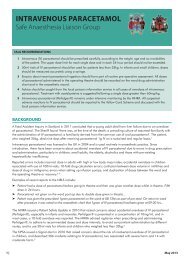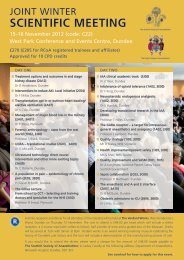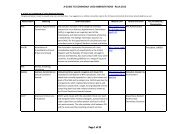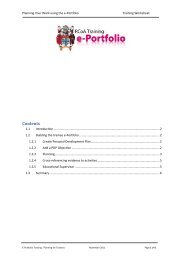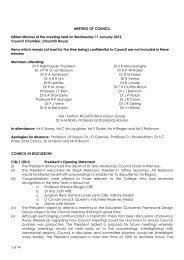Guidance on the provision of cardiac and thoracic anaesthesia ...
Guidance on the provision of cardiac and thoracic anaesthesia ...
Guidance on the provision of cardiac and thoracic anaesthesia ...
Create successful ePaper yourself
Turn your PDF publications into a flip-book with our unique Google optimized e-Paper software.
Chapter 19<br />
GUIDELINES FOR THE PROVISION OF<br />
anaes<strong>the</strong>tic services<br />
Cardiac <strong>and</strong> <strong>thoracic</strong><br />
anaes<strong>the</strong>sia services<br />
Author<br />
Dr D Smith, Southampt<strong>on</strong> General Hospital<br />
When c<strong>on</strong>sidering <strong>the</strong> provisi<strong>on</strong> <strong>of</strong> anaes<strong>the</strong>sia, <strong>the</strong><br />
Royal College <strong>of</strong> Anaes<strong>the</strong>tists recommends that <strong>the</strong><br />
following areas should be addressed. The goal is to<br />
ensure a comprehensive, quality service dedicated to <strong>the</strong><br />
care <strong>of</strong> patients <strong>and</strong> to <strong>the</strong> educati<strong>on</strong> <strong>and</strong> pr<strong>of</strong>essi<strong>on</strong>al<br />
development <strong>of</strong> staff. The provisi<strong>on</strong> <strong>of</strong> adequate funding<br />
to provide <strong>the</strong> services described should be c<strong>on</strong>sidered.<br />
These recommendati<strong>on</strong>s form <strong>the</strong> basis <strong>of</strong> <strong>the</strong> st<strong>and</strong>ard<br />
expected for departmental accreditati<strong>on</strong>.<br />
www.rcoa.ac.uk/gpas2013
<str<strong>on</strong>g>Guidance</str<strong>on</strong>g> <strong>on</strong> <strong>the</strong> provisi<strong>on</strong> <strong>of</strong> <strong>cardiac</strong> <strong>and</strong> <strong>thoracic</strong><br />
anaes<strong>the</strong>sia services<br />
Summary<br />
■■<br />
Each cardio<strong>thoracic</strong> unit must have c<strong>on</strong>sultant anaes<strong>the</strong>tists with dedicated, individual<br />
resp<strong>on</strong>sibility for <strong>cardiac</strong> <strong>and</strong> <strong>thoracic</strong> anaes<strong>the</strong>tic services.<br />
■■<br />
■■<br />
■■<br />
■■<br />
■■<br />
■■<br />
■■<br />
■■<br />
■■<br />
Minimum staffing levels to provide 24- hour c<strong>on</strong>sultant anaes<strong>the</strong>tic cover for <strong>the</strong>atres <strong>and</strong><br />
ICU equate to nine full-time equivalent c<strong>on</strong>sultant <strong>cardiac</strong> anaes<strong>the</strong>tists for 1,200 adult<br />
<strong>cardiac</strong> operati<strong>on</strong>s per year. 1<br />
Minimum m<strong>on</strong>itoring during bypass must c<strong>on</strong>form to <strong>the</strong> st<strong>and</strong>ards recommended by<br />
<strong>the</strong> joint working group <strong>of</strong> <strong>the</strong> Society <strong>of</strong> Clinical Perfusi<strong>on</strong> Scientists, Associati<strong>on</strong> <strong>of</strong><br />
Cardio<strong>thoracic</strong> Anaes<strong>the</strong>tists <strong>and</strong> Society <strong>of</strong> Cardio<strong>thoracic</strong> Surge<strong>on</strong>s. 2<br />
Post-operative recovery facilities for <strong>cardiac</strong> surgery should be appropriately staffed <strong>and</strong><br />
equipped, ring-fenced <strong>and</strong> located close to <strong>the</strong> <strong>the</strong>atres. 1,3–4<br />
In cardio<strong>thoracic</strong> units, <strong>the</strong>re must be immediate access to critical care facilities, which must<br />
be staffed by appropriately trained pers<strong>on</strong>nel. 1<br />
There must be appropriate support facilities provided <strong>on</strong> site for cardio<strong>thoracic</strong> units<br />
including perfusi<strong>on</strong> services, blood transfusi<strong>on</strong> services, microbiology, pharmacy,<br />
pathology, respiratory functi<strong>on</strong> testing <strong>and</strong> radiological services. These must be backed up<br />
by modern informati<strong>on</strong> technology (IT) systems. 1<br />
Special provisi<strong>on</strong> <strong>of</strong> staff, envir<strong>on</strong>ment, facilities <strong>and</strong> services must be made for children<br />
undergoing <strong>cardiac</strong> or <strong>thoracic</strong> procedures. 5<br />
Patients who have underg<strong>on</strong>e <strong>thoracic</strong> procedures must be managed in dedicated<br />
<strong>thoracic</strong> units post-operatively with access to an acute pain service <strong>and</strong> governed by pain<br />
relief protocols.<br />
C<strong>on</strong>sultant anaes<strong>the</strong>tists providing anaes<strong>the</strong>sia for <strong>cardiac</strong> or <strong>thoracic</strong> surgery are<br />
expected to maintain <strong>the</strong> individual competencies recommended by <strong>the</strong> Royal College <strong>of</strong><br />
Anaes<strong>the</strong>tists. 6 Evidence <strong>of</strong> c<strong>on</strong>tinuing educati<strong>on</strong>al <strong>and</strong> pr<strong>of</strong>essi<strong>on</strong>al development will be<br />
necessary to dem<strong>on</strong>strate fitness to practise in this specialty.<br />
Anaes<strong>the</strong>tic trainees attached to <strong>the</strong> <strong>cardiac</strong> or <strong>thoracic</strong> unit should be <strong>of</strong> appropriate<br />
seniority to benefit from higher training in this area <strong>and</strong> an anaes<strong>the</strong>tist training in<br />
cardio<strong>thoracic</strong> anaes<strong>the</strong>sia should be supervised at all times by an appropriately trained<br />
c<strong>on</strong>sultant or specialist. 6<br />
■■<br />
All cardio<strong>thoracic</strong> units must participate in local <strong>and</strong> nati<strong>on</strong>al audit. 7<br />
■■<br />
Patients receiving anaes<strong>the</strong>sia for <strong>cardiac</strong> or <strong>thoracic</strong> procedures should be provided with<br />
written informati<strong>on</strong> regarding <strong>the</strong>ir surgery <strong>and</strong> peri-operative care. 8–11<br />
1 Guidelines for <strong>the</strong> Provisi<strong>on</strong> <strong>of</strong> Anaes<strong>the</strong>tic Services 2013
<str<strong>on</strong>g>Guidance</str<strong>on</strong>g> <strong>on</strong> <strong>the</strong> provisi<strong>on</strong> <strong>of</strong> <strong>cardiac</strong> <strong>and</strong> <strong>thoracic</strong><br />
anaes<strong>the</strong>sia services<br />
Introducti<strong>on</strong>: <strong>the</strong> importance <strong>of</strong> anaes<strong>the</strong>tic services for <strong>cardiac</strong><br />
surgery<br />
■■<br />
■■<br />
■■<br />
■■<br />
■■<br />
■■<br />
■■<br />
Cardiac anaes<strong>the</strong>tic services are provided for patients undergoing <strong>cardiac</strong> <strong>and</strong> <strong>thoracic</strong><br />
vascular investigati<strong>on</strong>s <strong>and</strong> surgery.<br />
Cardiac surgery may involve adult, paediatric <strong>and</strong> ne<strong>on</strong>atal patients <strong>and</strong> includes all forms<br />
<strong>of</strong> open <strong>and</strong> closed heart surgery, whe<strong>the</strong>r elective or emergency. It also includes some<br />
interventi<strong>on</strong>al cardiological procedures, more comm<strong>on</strong>ly performed in children, but<br />
increasingly in adults, such as percutaneous atrial septal defect (ASD) <strong>and</strong> patent foramen<br />
ovale (PFO) closure <strong>and</strong> ablati<strong>on</strong> <strong>of</strong> aberrant pathways causing complex dysrhythmias. It<br />
may also include heart or heart/lung transplantati<strong>on</strong>, increasing use <strong>of</strong> ‘<strong>of</strong>f-pump’ surgery<br />
(performed without cardiopulm<strong>on</strong>ary bypass), <strong>and</strong> <strong>the</strong> use <strong>of</strong> ventricular assist devices<br />
(VADs) to support <strong>the</strong> failing circulati<strong>on</strong> for periods <strong>of</strong> days or weeks in <strong>the</strong> intensive care<br />
unit (ICU).<br />
Cardiac surgery is mainly carried out in specialist units within teaching hospitals or<br />
specialist hospitals dedicated to cardio<strong>thoracic</strong> work.<br />
Many factors are influential in determining <strong>the</strong> viability <strong>of</strong> a <strong>cardiac</strong> surgical unit.<br />
However, <strong>the</strong> most important <strong>of</strong> <strong>the</strong>se is clinical activity, based mainly <strong>on</strong> <strong>the</strong> yearly<br />
caseload <strong>of</strong> heart operati<strong>on</strong>s.<br />
The nature <strong>of</strong> <strong>cardiac</strong> surgery dem<strong>and</strong>s that all patients should be cared for postoperatively<br />
in a unit which c<strong>on</strong>forms to <strong>the</strong> st<strong>and</strong>ards <strong>of</strong> general Level 3 <strong>and</strong> 2 intensive<br />
care facilities.<br />
Evidence suggests that clinical excellence in <strong>cardiac</strong> anaes<strong>the</strong>sia has an important<br />
influence <strong>on</strong> outcome.<br />
Cardiac anaes<strong>the</strong>sia provides an important area <strong>of</strong> training for trainee anaes<strong>the</strong>tists. It<br />
<strong>of</strong>fers training in <strong>the</strong> peri-operative care <strong>of</strong> patients with severe heart <strong>and</strong> lung disease,<br />
essential for all anaes<strong>the</strong>tists whatever <strong>the</strong>ir future area <strong>of</strong> practice.<br />
The importance <strong>of</strong> anaes<strong>the</strong>tic services for <strong>thoracic</strong> surgery<br />
■■<br />
■■<br />
■■<br />
Thoracic surgery in adults includes surgery <strong>on</strong> <strong>the</strong> lungs (including lung transplantati<strong>on</strong>),<br />
pleura, thymus, oesophagus <strong>and</strong> o<strong>the</strong>r <strong>thoracic</strong> structures as well as <strong>the</strong> chest wall.<br />
Thoracic procedures include lobar resecti<strong>on</strong>, pneum<strong>on</strong>ectomy for malignant <strong>and</strong> n<strong>on</strong>malignant<br />
c<strong>on</strong>diti<strong>on</strong>s, mediastinoscopy <strong>and</strong> mediastinotomy, <strong>and</strong> br<strong>on</strong>choscopy for<br />
diagnostic <strong>and</strong> interventi<strong>on</strong>al indicati<strong>on</strong>s. Video-assisted thoracoscopic surgery (VATS) is<br />
also performed for drainage <strong>and</strong> investigati<strong>on</strong> <strong>of</strong> effusi<strong>on</strong>s, lung resecti<strong>on</strong>, sympa<strong>the</strong>ctomy<br />
<strong>and</strong> removal <strong>of</strong> mediastinal tumours. O<strong>the</strong>r procedures include surgical management<br />
<strong>of</strong> air-leaks, management <strong>of</strong> empyema, operati<strong>on</strong>s <strong>on</strong> <strong>the</strong> chest wall, endobr<strong>on</strong>chial laser<br />
surgery <strong>and</strong> tracheal stenting.<br />
Anaes<strong>the</strong>sia for lung transplantati<strong>on</strong>, although limited in <strong>the</strong> UK at present due to<br />
d<strong>on</strong>or shortage, may sometimes require <strong>the</strong> use <strong>of</strong> cardiopulm<strong>on</strong>ary bypass. There is<br />
also an exp<strong>and</strong>ing use <strong>of</strong> extracorporeal membrane oxygenati<strong>on</strong> (ECMO) for acute lung<br />
injury (ALI).<br />
Although <strong>thoracic</strong> surgical units usually exist as part <strong>of</strong> a cardio<strong>thoracic</strong> service within a<br />
larger hospital, <strong>the</strong>ir needs may vary to some extent from those <strong>of</strong> pure <strong>cardiac</strong> units.<br />
The Royal College <strong>of</strong> Anaes<strong>the</strong>tists 2
<str<strong>on</strong>g>Guidance</str<strong>on</strong>g> <strong>on</strong> <strong>the</strong> provisi<strong>on</strong> <strong>of</strong> <strong>cardiac</strong> <strong>and</strong> <strong>thoracic</strong><br />
anaes<strong>the</strong>sia services<br />
Levels <strong>of</strong> provisi<strong>on</strong> <strong>of</strong> service<br />
1 Staffing requirements<br />
Cardiac anaes<strong>the</strong>tic services<br />
1.1 Each unit should have a designated lead c<strong>on</strong>sultant anaes<strong>the</strong>tist who is resp<strong>on</strong>sible for <strong>cardiac</strong><br />
anaes<strong>the</strong>tic services.<br />
1.2 A c<strong>on</strong>sultant anaes<strong>the</strong>tist must be available c<strong>on</strong>tinuously, preferably through a dedicated<br />
<strong>cardiac</strong> anaes<strong>the</strong>tic <strong>on</strong>-call rota. Wherever <strong>cardiac</strong> anaes<strong>the</strong>sia <strong>and</strong> surgery are performed,<br />
<strong>the</strong>re should be a resident anaes<strong>the</strong>tist <strong>and</strong> a resident <strong>cardiac</strong> surge<strong>on</strong> capable <strong>of</strong> emergency<br />
chest re-opening.<br />
1.3 Minimum staffing levels to provide 24-hour c<strong>on</strong>sultant anaes<strong>the</strong>tic cover for <strong>the</strong>atres <strong>and</strong><br />
<strong>the</strong> ICU c<strong>on</strong>stitute nine full-time equivalent c<strong>on</strong>sultant <strong>cardiac</strong> anaes<strong>the</strong>tists for 1,200 adult<br />
<strong>cardiac</strong> surgery operati<strong>on</strong>s per year. 1<br />
1.4 The level <strong>of</strong> expertise <strong>and</strong> availability <strong>of</strong> anaes<strong>the</strong>tist <strong>and</strong> surge<strong>on</strong> must be adapted to <strong>the</strong><br />
evolving needs <strong>of</strong> <strong>the</strong> patient following surgery. In <strong>the</strong> early stages this will require <strong>the</strong><br />
immediate availability <strong>of</strong> both anaes<strong>the</strong>tist <strong>and</strong> surge<strong>on</strong>.<br />
1.5 Perfusi<strong>on</strong> services must be provided by suitably trained <strong>and</strong> accredited perfusi<strong>on</strong> technicians. 2<br />
1.6 Interventi<strong>on</strong>al cardiology services must take into account <strong>the</strong> likely impact <strong>on</strong> anaes<strong>the</strong>sia,<br />
intensive care <strong>and</strong> nursing resources according to patient acuity. General anaes<strong>the</strong>sia may<br />
be needed to facilitate complex interventi<strong>on</strong>s, or required in an emergency in <strong>the</strong> event <strong>of</strong><br />
major complicati<strong>on</strong>s during invasive cardiological procedures. Both eventualities require <strong>the</strong><br />
provisi<strong>on</strong> <strong>of</strong> anaes<strong>the</strong>tic staffing, assistance, equipment <strong>and</strong> m<strong>on</strong>itoring.<br />
Thoracic anaes<strong>the</strong>tic services<br />
1.7 Each unit should have a designated lead c<strong>on</strong>sultant anaes<strong>the</strong>tist for <strong>thoracic</strong> services.<br />
1.8 The complexity <strong>of</strong> <strong>the</strong> cases may necessitate additi<strong>on</strong>al sessi<strong>on</strong>al commitment for preoperative<br />
visiting <strong>and</strong> assessment.<br />
1.9 Two anaes<strong>the</strong>tists may be required for more complex procedures.<br />
1.10 A c<strong>on</strong>sultant anaes<strong>the</strong>tist must be available c<strong>on</strong>tinuously, preferably through a dedicated<br />
<strong>thoracic</strong> anaes<strong>the</strong>tic <strong>on</strong>-call rota, particularly if lung transplantati<strong>on</strong> is performed.<br />
1.11 It is essential that wherever <strong>thoracic</strong> anaes<strong>the</strong>sia <strong>and</strong> surgery are performed, <strong>the</strong>re should be a<br />
resident anaes<strong>the</strong>tist <strong>and</strong> <strong>thoracic</strong> surge<strong>on</strong>.<br />
1.12 The c<strong>on</strong>sultant anaes<strong>the</strong>tists in cardio<strong>thoracic</strong> units will be resp<strong>on</strong>sible for <strong>the</strong> provisi<strong>on</strong><br />
<strong>of</strong> service, teaching, producti<strong>on</strong> <strong>of</strong> protocols, management, research <strong>and</strong> audit. Adequate<br />
sessi<strong>on</strong>al time will be required for <strong>the</strong>se activities.<br />
2 Equipment, support services, facilities <strong>and</strong> envir<strong>on</strong>ment<br />
Equipment <strong>and</strong> m<strong>on</strong>itoring<br />
2.1 Cardiac anaes<strong>the</strong>sia <strong>and</strong> surgery are carried out under intensive physiological patient<br />
m<strong>on</strong>itoring. Routinely used m<strong>on</strong>itoring during <strong>cardiac</strong> surgery will include <strong>the</strong> following: 12–13<br />
■■<br />
■■<br />
in <strong>the</strong> inducti<strong>on</strong>/anaes<strong>the</strong>tic room: electrocardiogram (ECG); pulse oximetry; invasive <strong>and</strong><br />
n<strong>on</strong>-invasive blood pressure (BP) m<strong>on</strong>itoring; respired gas m<strong>on</strong>itoring<br />
during surgery: ECG; pulse oximetry; invasive pressure m<strong>on</strong>itoring (systemic <strong>and</strong><br />
pulm<strong>on</strong>ary artery, <strong>and</strong> central venous pressures); respired gas m<strong>on</strong>itoring; measurement<br />
<strong>of</strong> body core temperature. Transoesophageal echocardiography should be immediately<br />
available. Complex cases may require more sophisticated m<strong>on</strong>itoring, such as <strong>cardiac</strong><br />
output estimati<strong>on</strong> or transcranial near-infra-red spectroscopy<br />
3 Guidelines for <strong>the</strong> Provisi<strong>on</strong> <strong>of</strong> Anaes<strong>the</strong>tic Services 2013
<str<strong>on</strong>g>Guidance</str<strong>on</strong>g> <strong>on</strong> <strong>the</strong> provisi<strong>on</strong> <strong>of</strong> <strong>cardiac</strong> <strong>and</strong> <strong>thoracic</strong><br />
anaes<strong>the</strong>sia services<br />
■■<br />
during <strong>the</strong> transfer <strong>of</strong> <strong>the</strong> patient at <strong>the</strong> end <strong>of</strong> surgery to post-operative care unit: ECG;<br />
invasive BP; pulse oximetry; disc<strong>on</strong>necti<strong>on</strong> alarm for any mechanical ventilati<strong>on</strong> system;<br />
fracti<strong>on</strong>al inspired oxygen c<strong>on</strong>centrati<strong>on</strong>; end tidal carb<strong>on</strong> dioxide.<br />
2.2 M<strong>on</strong>itoring during cardiopulm<strong>on</strong>ary bypass must c<strong>on</strong>form to <strong>the</strong> st<strong>and</strong>ards recommended<br />
by <strong>the</strong> joint working group <strong>of</strong> <strong>the</strong> Society <strong>of</strong> Clinical Perfusi<strong>on</strong> Scientists, Associati<strong>on</strong> <strong>of</strong><br />
Cardio<strong>thoracic</strong> Anaes<strong>the</strong>tists <strong>and</strong> Society <strong>of</strong> Cardio<strong>thoracic</strong> Surge<strong>on</strong>s. 2<br />
2.3 Comprehensive m<strong>on</strong>itoring facilities are also required for complex <strong>thoracic</strong> cases, 12–13 for<br />
example, facilities for pulm<strong>on</strong>ary artery ca<strong>the</strong>terisati<strong>on</strong> <strong>and</strong> <strong>cardiac</strong> output measurement. For<br />
patients undergoing lung transplantati<strong>on</strong>, additi<strong>on</strong>al facilities will be needed.<br />
2.4 On ICU, equipment for a variety <strong>of</strong> methods <strong>of</strong> mechanical ventilati<strong>on</strong> is required.<br />
Facilities<br />
2.5 Dedicated <strong>thoracic</strong>, <strong>cardiac</strong>, or cardio<strong>thoracic</strong> wards are desirable.<br />
2.6 Cardiac surgery must take place in dedicated cardio<strong>thoracic</strong> operating rooms. It is unlikely<br />
that an operating room will be kept available at all times for emergencies. It is preferable that<br />
all <strong>cardiac</strong> surgery be carried out in a dedicated envir<strong>on</strong>ment whenever possible.<br />
2.7 Many units care for selected <strong>cardiac</strong> surgical patients in <strong>the</strong> immediate post-operative<br />
period in facilities o<strong>the</strong>r than designated ICUs. These are variously referred to as <strong>the</strong> high<br />
dependency unit (HDU), <strong>cardiac</strong> recovery, <strong>cardiac</strong> fast-track or by ano<strong>the</strong>r similar name. They<br />
have in comm<strong>on</strong> <strong>the</strong> aim <strong>of</strong> selecting patients <strong>and</strong> minimising or abolishing <strong>the</strong> period <strong>of</strong><br />
mechanical ventilati<strong>on</strong> in <strong>the</strong> post-operative period. The patient m<strong>on</strong>itoring requirements <strong>of</strong><br />
such a facility are no less than <strong>the</strong> essential m<strong>on</strong>itoring requirements <strong>of</strong> patients cared for in<br />
ICU, <strong>and</strong> <strong>the</strong> governance arrangements should also be <strong>the</strong> same.<br />
2.8 After major <strong>thoracic</strong> surgery, patients must be transferred to a properly equipped <strong>and</strong> staffed<br />
area. In <strong>the</strong> United Kingdom most patients will return to an HDU. However, in some<br />
instances, for example, elderly patients who have had oesophageal surgery <strong>and</strong> some patients<br />
undergoing lung surgery, <strong>the</strong>re may be a need for post-operative mechanical ventilati<strong>on</strong> <strong>on</strong><br />
ICU. Access to ICU or HDU is <strong>the</strong>refore essential. Nursing staff <strong>on</strong> ICUs <strong>and</strong> HDUs receiving<br />
patients after <strong>thoracic</strong> surgery should be trained in <strong>thoracic</strong> nursing care <strong>and</strong> have access to <strong>the</strong><br />
same services that are available <strong>on</strong> a general <strong>thoracic</strong> ward.<br />
2.9 There should be an appropriately sized, equipped <strong>and</strong> staffed post-anaes<strong>the</strong>tic recovery unit<br />
for those patients who do not require HDU or ICU.<br />
2.10 On rare occasi<strong>on</strong>s, when unexpected difficulties arise in <strong>thoracic</strong> surgery, access to<br />
cardiopulm<strong>on</strong>ary bypass is essential.<br />
Support services<br />
2.11 Haematology, blood transfusi<strong>on</strong> <strong>and</strong> biochemistry services should be available with rapid<br />
access for both <strong>cardiac</strong> <strong>and</strong> <strong>thoracic</strong> surgery. In <strong>cardiac</strong> surgery, <strong>the</strong>re should be satellite or<br />
point <strong>of</strong> care laboratory facilities in or near <strong>the</strong> operating room for <strong>the</strong> measurement <strong>of</strong> blood<br />
gases, electrolytes, haemoglobin <strong>and</strong> anticoagulati<strong>on</strong> (including thromboelastography or<br />
thromboelestometry).<br />
2.12 There should be immediate access to X-ray facilities, <strong>and</strong> computerised axial tomography (CT)<br />
<strong>and</strong> magnetic res<strong>on</strong>ance imaging (MRI) services must be available for patients undergoing<br />
<strong>cardiac</strong> or <strong>thoracic</strong> surgery. For <strong>cardiac</strong> patients, dedicated echocardiography equipment,<br />
including trans-oesophageal echo (TOE) should be available in <strong>the</strong> operating suite. The<br />
dem<strong>and</strong> for echocardiography services is likely to c<strong>on</strong>tinue to increase in <strong>the</strong> future, especially<br />
for 3D echo in c<strong>on</strong>genital <strong>cardiac</strong> surgery.<br />
2.13 Access to respiratory functi<strong>on</strong> measurements is required for patients undergoing <strong>thoracic</strong><br />
surgery, including facility for pulm<strong>on</strong>ary exercise testing.<br />
The Royal College <strong>of</strong> Anaes<strong>the</strong>tists 4
<str<strong>on</strong>g>Guidance</str<strong>on</strong>g> <strong>on</strong> <strong>the</strong> provisi<strong>on</strong> <strong>of</strong> <strong>cardiac</strong> <strong>and</strong> <strong>thoracic</strong><br />
anaes<strong>the</strong>sia services<br />
2.14 Physio<strong>the</strong>rapy services are required during <strong>the</strong> pre-operative preparati<strong>on</strong> <strong>and</strong> post-operative<br />
care <strong>of</strong> patients undergoing cardio<strong>thoracic</strong> surgery.<br />
2.15 Medical physics or o<strong>the</strong>r suitably qualified technicians are required to maintain, repair <strong>and</strong><br />
calibrate anaes<strong>the</strong>tic machines, mechanical ventilators, m<strong>on</strong>itors, infusi<strong>on</strong> equipment, <strong>the</strong><br />
heart/lung machines, cooling/warming devices <strong>and</strong> o<strong>the</strong>r machinery that may be essential<br />
such as intra-aortic counter-pulsati<strong>on</strong> ballo<strong>on</strong> pump equipment. Some specialised equipment<br />
may need to be maintained by c<strong>on</strong>tractual arrangement with an external supplier.<br />
2.16 For patients undergoing <strong>thoracic</strong> surgery, physicians <strong>and</strong> surge<strong>on</strong>s experienced in specialist<br />
n<strong>on</strong>-<strong>thoracic</strong> areas, such as <strong>cardiac</strong> <strong>and</strong> endocrine disease, should be available for c<strong>on</strong>sultati<strong>on</strong>.<br />
2.17 The provisi<strong>on</strong> <strong>of</strong> an acute pain service is necessary for <strong>thoracic</strong> surgery. Pain relief <strong>and</strong> clinical<br />
management protocols must be clearly defined for <strong>thoracic</strong> <strong>and</strong> <strong>cardiac</strong> patients.<br />
3 Areas <strong>of</strong> special requirement<br />
3.1 Children undergoing <strong>thoracic</strong> surgery have special requirements <strong>and</strong> <strong>the</strong> resp<strong>on</strong>sibility for<br />
paediatric anaes<strong>the</strong>tic care may be shared with paediatric anaes<strong>the</strong>tists. 5<br />
3.2 Paediatric patients who have underg<strong>on</strong>e <strong>cardiac</strong> surgery must be cared for in a unit designed<br />
<strong>and</strong> equipped to care for paediatric patients, <strong>and</strong> staffed by appropriately trained nurses. Such<br />
a unit should meet <strong>the</strong> st<strong>and</strong>ards laid down for paediatric intensive care, including adequate<br />
arrangements for retrieval <strong>and</strong> transfer. 5<br />
4 Training <strong>and</strong> educati<strong>on</strong><br />
4.1 Cardiac <strong>and</strong> <strong>thoracic</strong> anaes<strong>the</strong>sia is a ‘key unit <strong>of</strong> training’ for intermediate level training in<br />
anaes<strong>the</strong>sia. 6 Trainee anaes<strong>the</strong>tists must be <strong>of</strong> appropriate seniority to be able to benefit from<br />
this area <strong>of</strong> training, at least specialist trainee year 3 or above.<br />
4.2 Anaes<strong>the</strong>tists intending to undertake anaes<strong>the</strong>sia for <strong>cardiac</strong> or <strong>thoracic</strong> surgery should<br />
have received training to higher level in adult intensive care, adult <strong>cardiac</strong> <strong>and</strong>/or<br />
<strong>thoracic</strong> anaes<strong>the</strong>sia for a minimum <strong>of</strong> <strong>on</strong>e year in recognised training centres as part <strong>of</strong><br />
general training. 6<br />
4.3 An anaes<strong>the</strong>tist training in cardio<strong>thoracic</strong> anaes<strong>the</strong>sia should be supervised at all times by<br />
an appropriately trained c<strong>on</strong>sultant, <strong>and</strong> normally should not be expected to supervise o<strong>the</strong>r<br />
trainees in <strong>the</strong>atre.<br />
4.4 The number <strong>of</strong> centres that perform <strong>thoracic</strong> surgery is decreasing. It is <strong>the</strong>refore essential<br />
that <strong>the</strong> training opportunities for anaes<strong>the</strong>tists, nursing staff, physio<strong>the</strong>rapists <strong>and</strong> o<strong>the</strong>r staff<br />
are used to <strong>the</strong> maximum, <strong>and</strong> that teaching <strong>and</strong> training in <strong>thoracic</strong> anaes<strong>the</strong>sia are given a<br />
high priority.<br />
5 Research <strong>and</strong> audit<br />
5.1 Most research in cardio<strong>thoracic</strong> anaes<strong>the</strong>sia will be undertaken in specialist cardio<strong>thoracic</strong><br />
units <strong>and</strong> must <strong>the</strong>refore be given high priority.<br />
5.2 Regular clinical audit <strong>of</strong> <strong>the</strong> work <strong>of</strong> cardio<strong>thoracic</strong> units <strong>and</strong> cardio<strong>thoracic</strong> anaes<strong>the</strong>sia<br />
is essential.<br />
6 Organisati<strong>on</strong> <strong>and</strong> administrati<strong>on</strong><br />
6.1 Perfusi<strong>on</strong> services must be included in a clinical directorate or equivalent, under <strong>the</strong><br />
managerial c<strong>on</strong>trol <strong>of</strong> an NHS c<strong>on</strong>sultant who may be a c<strong>on</strong>sultant anaes<strong>the</strong>tist.<br />
6.2 Clinical protocols should be developed from nati<strong>on</strong>al guidelines <strong>and</strong> reviewed <strong>on</strong> a<br />
regular basis.<br />
5 Guidelines for <strong>the</strong> Provisi<strong>on</strong> <strong>of</strong> Anaes<strong>the</strong>tic Services 2013
<str<strong>on</strong>g>Guidance</str<strong>on</strong>g> <strong>on</strong> <strong>the</strong> provisi<strong>on</strong> <strong>of</strong> <strong>cardiac</strong> <strong>and</strong> <strong>thoracic</strong><br />
anaes<strong>the</strong>sia services<br />
7 Patient informati<strong>on</strong><br />
7.1 Booklets providing informati<strong>on</strong> for patients about <strong>the</strong>ir stay in hospital should be available<br />
for all patients. This will include <strong>the</strong> patient informati<strong>on</strong> booklets published by <strong>the</strong> British<br />
Heart Foundati<strong>on</strong> <strong>on</strong> <strong>cardiac</strong> disease, preventi<strong>on</strong>, treatment <strong>and</strong> lifestyle modificati<strong>on</strong> <strong>and</strong><br />
informati<strong>on</strong> <strong>on</strong> <strong>the</strong> anaes<strong>the</strong>tic. 8–11<br />
7.2 Informati<strong>on</strong> about <strong>cardiac</strong> rehabilitati<strong>on</strong> generally, <strong>and</strong> informati<strong>on</strong> regarding <strong>the</strong> availability <strong>of</strong><br />
such courses locally, should also be available.<br />
References<br />
1 Models <strong>of</strong> care for <strong>the</strong> delivery <strong>of</strong> <strong>cardiac</strong> surgery. Joint report from <strong>the</strong> Society for Cardio<strong>thoracic</strong> Surgery in Great Britain <strong>and</strong><br />
Irel<strong>and</strong> (SCTS) <strong>and</strong> <strong>the</strong> British Cardiac Society (BCS). SCTS, L<strong>on</strong>d<strong>on</strong> 2001 (www.scts.org).<br />
2 Recommendati<strong>on</strong>s for st<strong>and</strong>ards <strong>of</strong> m<strong>on</strong>itoring during cardiopulm<strong>on</strong>ary bypass. ACTA, L<strong>on</strong>d<strong>on</strong> 2007 (www.acta.org.uk/<br />
store/docs/publicati<strong>on</strong>s/CPBRecommendati<strong>on</strong>s2007-298972-31-08-2011.pdf).<br />
3 Immediate post-anaes<strong>the</strong>sia recovery. AAGBI, L<strong>on</strong>d<strong>on</strong> 2013 (www.aagbi.org/sites/default/files/Immediate%20Postanaes<strong>the</strong>sia%20recovery%202013%20supplement.pdf).<br />
4 <str<strong>on</strong>g>Guidance</str<strong>on</strong>g> <strong>on</strong> provisi<strong>on</strong> <strong>of</strong> anaes<strong>the</strong>sia services for post-operative care. RCoA, L<strong>on</strong>d<strong>on</strong> 2013 (www.rcoa.ac.uk/node/12216).<br />
5 <str<strong>on</strong>g>Guidance</str<strong>on</strong>g> <strong>on</strong> <strong>the</strong> provisi<strong>on</strong> <strong>of</strong> paediatric anaes<strong>the</strong>sia services. RCoA, L<strong>on</strong>d<strong>on</strong> 2013 (www.rcoa.ac.uk/node/12429).<br />
6 CCT in anaes<strong>the</strong>sia, Parts I–IV. RCoA, L<strong>on</strong>d<strong>on</strong> 2009 (updated June 2012) (www.rcoa.ac.uk/node/230).<br />
7 Audit <strong>of</strong> cardio<strong>thoracic</strong> surgical practice. SCTS, L<strong>on</strong>d<strong>on</strong>, 1999 (www.scts.org).<br />
8 The NHS Heart Improvement Programme. Getting it right – improving <strong>the</strong> c<strong>on</strong>sent process for <strong>cardiac</strong> surgery (http://tna.<br />
europarchive.org/20091107055023/heart.nhs.uk/c<strong>on</strong>sent).<br />
9 Raising <strong>the</strong> st<strong>and</strong>ard: informati<strong>on</strong> for patients. RCoA, L<strong>on</strong>d<strong>on</strong> 2003 (www.rcoa.ac.uk/node/2136).<br />
10 <str<strong>on</strong>g>Guidance</str<strong>on</strong>g> <strong>on</strong> <strong>the</strong> provisi<strong>on</strong> <strong>of</strong> anaes<strong>the</strong>sia services for pre-operative assessment <strong>and</strong> preparati<strong>on</strong>. RCoA, L<strong>on</strong>d<strong>on</strong> 2013 (www.<br />
rcoa.ac.uk/node/12214).<br />
11 Your anaes<strong>the</strong>tic for heart surgery. ACTA, July 2006 (www.acta.org.uk/store/docs/publicati<strong>on</strong>s/ACTA_Anaes<strong>the</strong>tic_For_Heart_<br />
Surgery-777866-31-08-2011.doc).<br />
12 St<strong>and</strong>ard <strong>of</strong> m<strong>on</strong>itoring during anaes<strong>the</strong>sia <strong>and</strong> recovery (4th Editi<strong>on</strong>). AAGBI, L<strong>on</strong>d<strong>on</strong> 2007 (www.aagbi.org/publicati<strong>on</strong>s/<br />
guidelines/docs/st<strong>and</strong>ards<strong>of</strong>m<strong>on</strong>itoring07.pdf).<br />
13 <str<strong>on</strong>g>Guidance</str<strong>on</strong>g> <strong>on</strong> provisi<strong>on</strong> <strong>of</strong> anaes<strong>the</strong>sia services for intra-operative care. RCoA, L<strong>on</strong>d<strong>on</strong> 2013 (www.rcoa.ac.uk/node/12215).<br />
The Royal College <strong>of</strong> Anaes<strong>the</strong>tists 6




